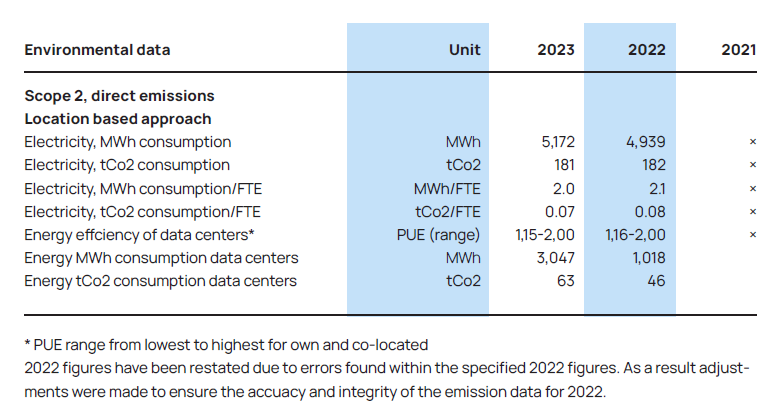Comparing environmental data like emission equivalents and Power Usage Effectiveness from data centres among companies aids in enhancing sustainability management.
ECIT's ESG scorecard features energy usage (kWh), CO2 equivalent emissions, and data centre efficiency (Power Usage Effectiveness).
Energy
ECIT is reporting according to Scope 2 Greenhouse Gas (GHG) emissions. Scope 2 represents one of the largest sources of GHG emissions globally.
A significant portion of ECIT's energy consumption stems from its office locations across ten countries. In addition to our office locations, we expanded our data center capacity in 2023 through acquisitions. Recognising the significance of this expansion, we now disclose the energy consumption from data centers separately.
Most of our locations are covered in the data input. Some subsidiaries have electricity usage included in rental agreements, preventing separate reporting. However, these companies represent a small percentage of the total, so we find the data to be representative and reportable.
Energy usage measures total kWh consumption (in thousands) and kWh per FTE. Additionally, input has been used to calculate GHG emissions using the location based GHG protocol emissions calculation tool.
The total amount of kWh consumption, excluding data centres, in 2023 amounts to 5,172 thousand and 2.0 thousand per FTE.
In 2023, total emissions excluding data centres were 181 kg CO2 equivalents, at 0.07 per FTE.
PUE-efficiency data centres
A metric widely used to measure the energy efficiency of a data centre is Power Usage Efficiency- PUE.
PUE describes our environmental footprint and is an accepted method for comparing data centre environmental impacts. It's calculated by dividing the power entering a data centre by the energy used for computer infrastructure.
PUE is expressed as a ratio, with higher efficiency indicated by a quotient approaching 1. ECIT currently operates 15 data centers, including co-located facilities, with Power Usage Effectiveness (PUE) figures ranging from 1.2 to 2.0, averaging at 1.4 in 2023 and is on level with last year. Measures are in place to ensure the efficient utilisation of heat generated by our data centers within local communities wherever feasible.
Environmental – 2024 focus
ECIT’s goal is to create higher transparency on the Group’s level of Carbon Emissions. In 2024, we will continue to build on the data fundament achieved for 2023 concerning our energy consumption.
Further steps will be taken to enhance data quality, allowing us to use data for decision-making processes and set future targets and prepare for the CSRD framework applicable from 2025 for ECIT.
Relevant Certifications
Some of our subsidiaries have obtained certifications in compliance with ISO 14001 for Environmental Management Systems and ISO 9001 for Quality Management Systems.

